CHEVROLET CITY EXPRESS 2018 Workshop Manual
Manufacturer: CHEVROLET, Model Year: 2018, Model line: CITY EXPRESS, Model: CHEVROLET CITY EXPRESS 2018Pages: 287, PDF Size: 4.19 MB
Page 51 of 287
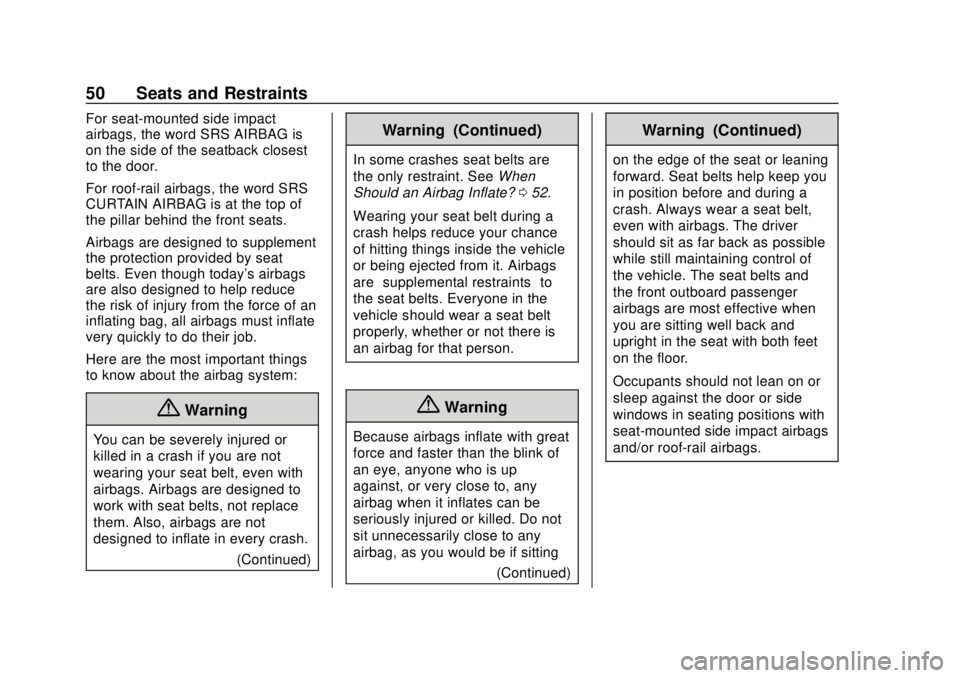
Chevrolet City Express Owner Manual (GMNA-Localizing-U.S./Canada-
11683523) - 2018 - CRC - 7/10/17
50 Seats and Restraints
For seat-mounted side impact
airbags, the word SRS AIRBAG is
on the side of the seatback closest
to the door.
For roof-rail airbags, the word SRS
CURTAIN AIRBAG is at the top of
the pillar behind the front seats.
Airbags are designed to supplement
the protection provided by seat
belts. Even though today's airbags
are also designed to help reduce
the risk of injury from the force of an
inflating bag, all airbags must inflate
very quickly to do their job.
Here are the most important things
to know about the airbag system:
{Warning
You can be severely injured or
killed in a crash if you are not
wearing your seat belt, even with
airbags. Airbags are designed to
work with seat belts, not replace
them. Also, airbags are not
designed to inflate in every crash.(Continued)
Warning (Continued)
In some crashes seat belts are
the only restraint. See When
Should an Airbag Inflate? 052.
Wearing your seat belt during a
crash helps reduce your chance
of hitting things inside the vehicle
or being ejected from it. Airbags
are “supplemental restraints” to
the seat belts. Everyone in the
vehicle should wear a seat belt
properly, whether or not there is
an airbag for that person.
{Warning
Because airbags inflate with great
force and faster than the blink of
an eye, anyone who is up
against, or very close to, any
airbag when it inflates can be
seriously injured or killed. Do not
sit unnecessarily close to any
airbag, as you would be if sitting
(Continued)
Warning (Continued)
on the edge of the seat or leaning
forward. Seat belts help keep you
in position before and during a
crash. Always wear a seat belt,
even with airbags. The driver
should sit as far back as possible
while still maintaining control of
the vehicle. The seat belts and
the front outboard passenger
airbags are most effective when
you are sitting well back and
upright in the seat with both feet
on the floor.
Occupants should not lean on or
sleep against the door or side
windows in seating positions with
seat-mounted side impact airbags
and/or roof-rail airbags.
Page 52 of 287
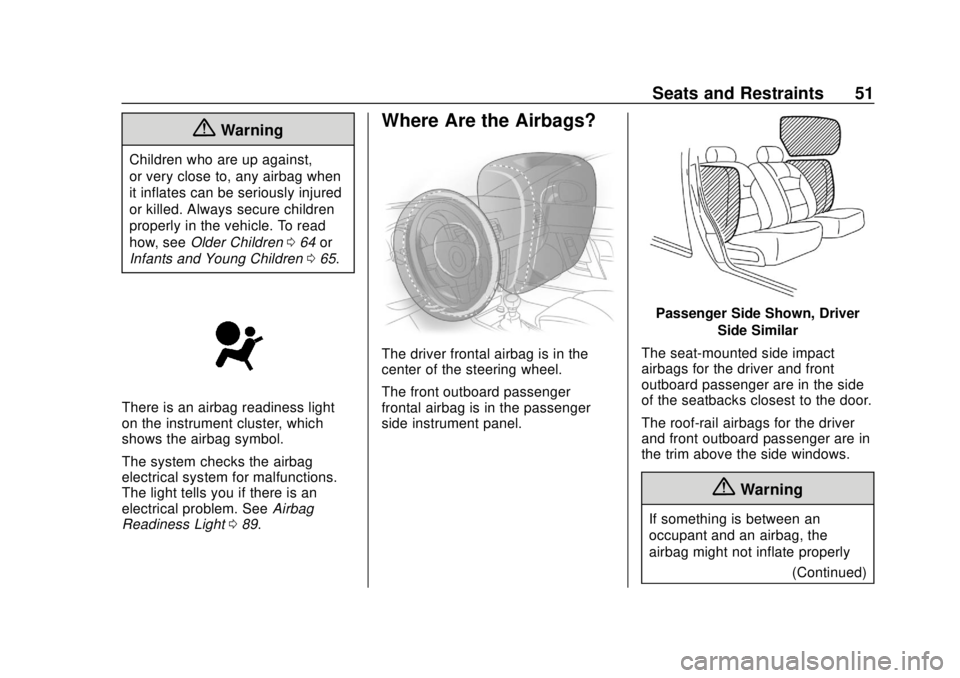
Chevrolet City Express Owner Manual (GMNA-Localizing-U.S./Canada-
11683523) - 2018 - CRC - 7/10/17
Seats and Restraints 51
{Warning
Children who are up against,
or very close to, any airbag when
it inflates can be seriously injured
or killed. Always secure children
properly in the vehicle. To read
how, seeOlder Children 064 or
Infants and Young Children 065.
There is an airbag readiness light
on the instrument cluster, which
shows the airbag symbol.
The system checks the airbag
electrical system for malfunctions.
The light tells you if there is an
electrical problem. See Airbag
Readiness Light 089.
Where Are the Airbags?
The driver frontal airbag is in the
center of the steering wheel.
The front outboard passenger
frontal airbag is in the passenger
side instrument panel.
Passenger Side Shown, Driver
Side Similar
The seat-mounted side impact
airbags for the driver and front
outboard passenger are in the side
of the seatbacks closest to the door.
The roof-rail airbags for the driver
and front outboard passenger are in
the trim above the side windows.
{Warning
If something is between an
occupant and an airbag, the
airbag might not inflate properly (Continued)
Page 53 of 287
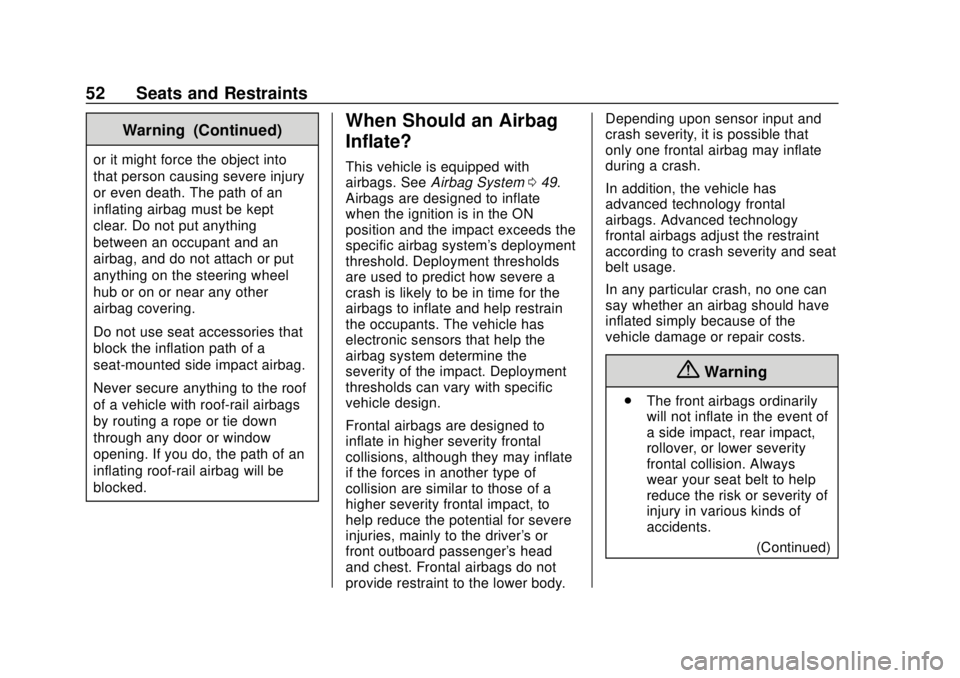
Chevrolet City Express Owner Manual (GMNA-Localizing-U.S./Canada-
11683523) - 2018 - CRC - 7/10/17
52 Seats and Restraints
Warning (Continued)
or it might force the object into
that person causing severe injury
or even death. The path of an
inflating airbag must be kept
clear. Do not put anything
between an occupant and an
airbag, and do not attach or put
anything on the steering wheel
hub or on or near any other
airbag covering.
Do not use seat accessories that
block the inflation path of a
seat-mounted side impact airbag.
Never secure anything to the roof
of a vehicle with roof-rail airbags
by routing a rope or tie‐down
through any door or window
opening. If you do, the path of an
inflating roof-rail airbag will be
blocked.
When Should an Airbag
Inflate?
This vehicle is equipped with
airbags. SeeAirbag System 049.
Airbags are designed to inflate
when the ignition is in the ON
position and the impact exceeds the
specific airbag system's deployment
threshold. Deployment thresholds
are used to predict how severe a
crash is likely to be in time for the
airbags to inflate and help restrain
the occupants. The vehicle has
electronic sensors that help the
airbag system determine the
severity of the impact. Deployment
thresholds can vary with specific
vehicle design.
Frontal airbags are designed to
inflate in higher severity frontal
collisions, although they may inflate
if the forces in another type of
collision are similar to those of a
higher severity frontal impact, to
help reduce the potential for severe
injuries, mainly to the driver's or
front outboard passenger's head
and chest. Frontal airbags do not
provide restraint to the lower body. Depending upon sensor input and
crash severity, it is possible that
only one frontal airbag may inflate
during a crash.
In addition, the vehicle has
advanced technology frontal
airbags. Advanced technology
frontal airbags adjust the restraint
according to crash severity and seat
belt usage.
In any particular crash, no one can
say whether an airbag should have
inflated simply because of the
vehicle damage or repair costs.
{Warning
.
The front airbags ordinarily
will not inflate in the event of
a side impact, rear impact,
rollover, or lower severity
frontal collision. Always
wear your seat belt to help
reduce the risk or severity of
injury in various kinds of
accidents.
(Continued)
Page 54 of 287
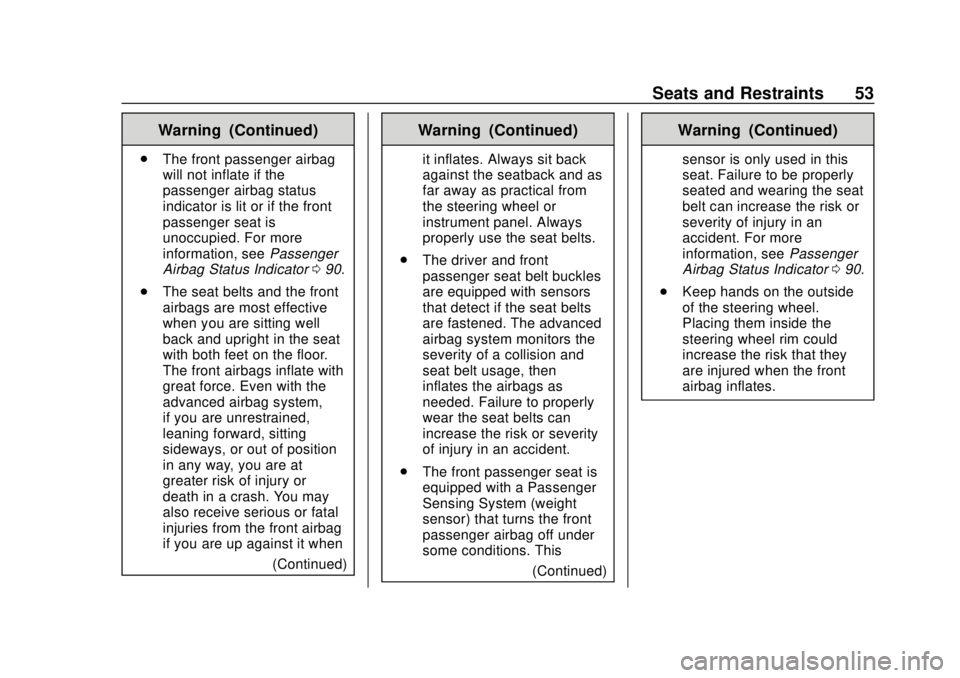
Chevrolet City Express Owner Manual (GMNA-Localizing-U.S./Canada-
11683523) - 2018 - CRC - 7/10/17
Seats and Restraints 53
Warning (Continued)
.The front passenger airbag
will not inflate if the
passenger airbag status
indicator is lit or if the front
passenger seat is
unoccupied. For more
information, see Passenger
Airbag Status Indicator 090.
. The seat belts and the front
airbags are most effective
when you are sitting well
back and upright in the seat
with both feet on the floor.
The front airbags inflate with
great force. Even with the
advanced airbag system,
if you are unrestrained,
leaning forward, sitting
sideways, or out of position
in any way, you are at
greater risk of injury or
death in a crash. You may
also receive serious or fatal
injuries from the front airbag
if you are up against it when
(Continued)
Warning (Continued)
it inflates. Always sit back
against the seatback and as
far away as practical from
the steering wheel or
instrument panel. Always
properly use the seat belts.
. The driver and front
passenger seat belt buckles
are equipped with sensors
that detect if the seat belts
are fastened. The advanced
airbag system monitors the
severity of a collision and
seat belt usage, then
inflates the airbags as
needed. Failure to properly
wear the seat belts can
increase the risk or severity
of injury in an accident.
. The front passenger seat is
equipped with a Passenger
Sensing System (weight
sensor) that turns the front
passenger airbag off under
some conditions. This
(Continued)
Warning (Continued)
sensor is only used in this
seat. Failure to be properly
seated and wearing the seat
belt can increase the risk or
severity of injury in an
accident. For more
information, seePassenger
Airbag Status Indicator 090.
. Keep hands on the outside
of the steering wheel.
Placing them inside the
steering wheel rim could
increase the risk that they
are injured when the front
airbag inflates.
Page 55 of 287
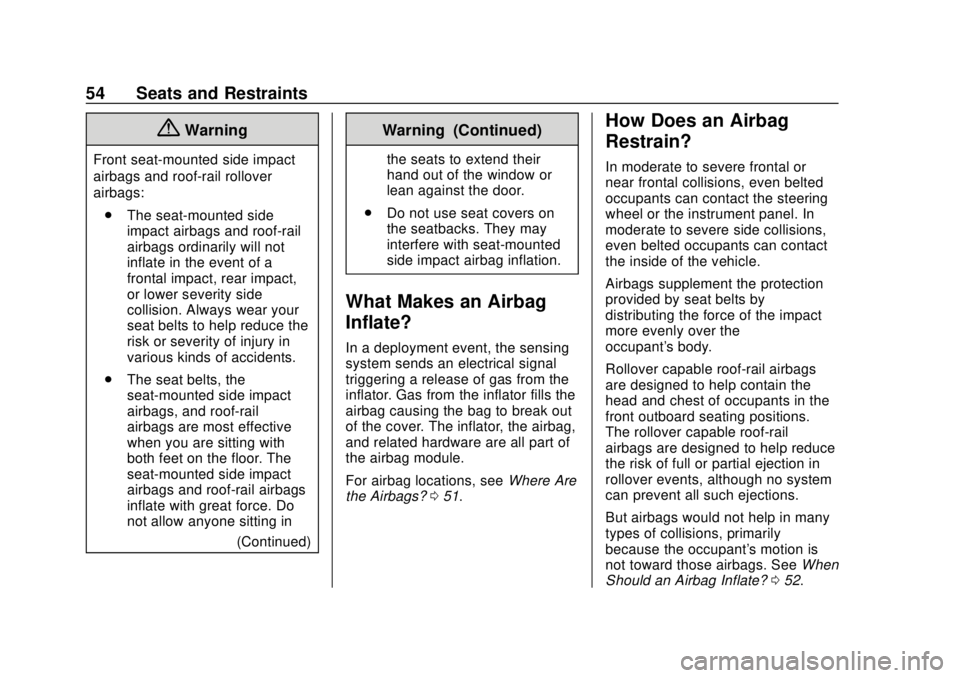
Chevrolet City Express Owner Manual (GMNA-Localizing-U.S./Canada-
11683523) - 2018 - CRC - 7/10/17
54 Seats and Restraints
{Warning
Front seat-mounted side impact
airbags and roof-rail rollover
airbags:. The seat-mounted side
impact airbags and roof-rail
airbags ordinarily will not
inflate in the event of a
frontal impact, rear impact,
or lower severity side
collision. Always wear your
seat belts to help reduce the
risk or severity of injury in
various kinds of accidents.
. The seat belts, the
seat-mounted side impact
airbags, and roof-rail
airbags are most effective
when you are sitting with
both feet on the floor. The
seat-mounted side impact
airbags and roof-rail airbags
inflate with great force. Do
not allow anyone sitting in
(Continued)
Warning (Continued)
the seats to extend their
hand out of the window or
lean against the door.
. Do not use seat covers on
the seatbacks. They may
interfere with seat-mounted
side impact airbag inflation.
What Makes an Airbag
Inflate?
In a deployment event, the sensing
system sends an electrical signal
triggering a release of gas from the
inflator. Gas from the inflator fills the
airbag causing the bag to break out
of the cover. The inflator, the airbag,
and related hardware are all part of
the airbag module.
For airbag locations, see Where Are
the Airbags? 051.
How Does an Airbag
Restrain?
In moderate to severe frontal or
near frontal collisions, even belted
occupants can contact the steering
wheel or the instrument panel. In
moderate to severe side collisions,
even belted occupants can contact
the inside of the vehicle.
Airbags supplement the protection
provided by seat belts by
distributing the force of the impact
more evenly over the
occupant's body.
Rollover capable roof-rail airbags
are designed to help contain the
head and chest of occupants in the
front outboard seating positions.
The rollover capable roof-rail
airbags are designed to help reduce
the risk of full or partial ejection in
rollover events, although no system
can prevent all such ejections.
But airbags would not help in many
types of collisions, primarily
because the occupant's motion is
not toward those airbags. See When
Should an Airbag Inflate? 052.
Page 56 of 287
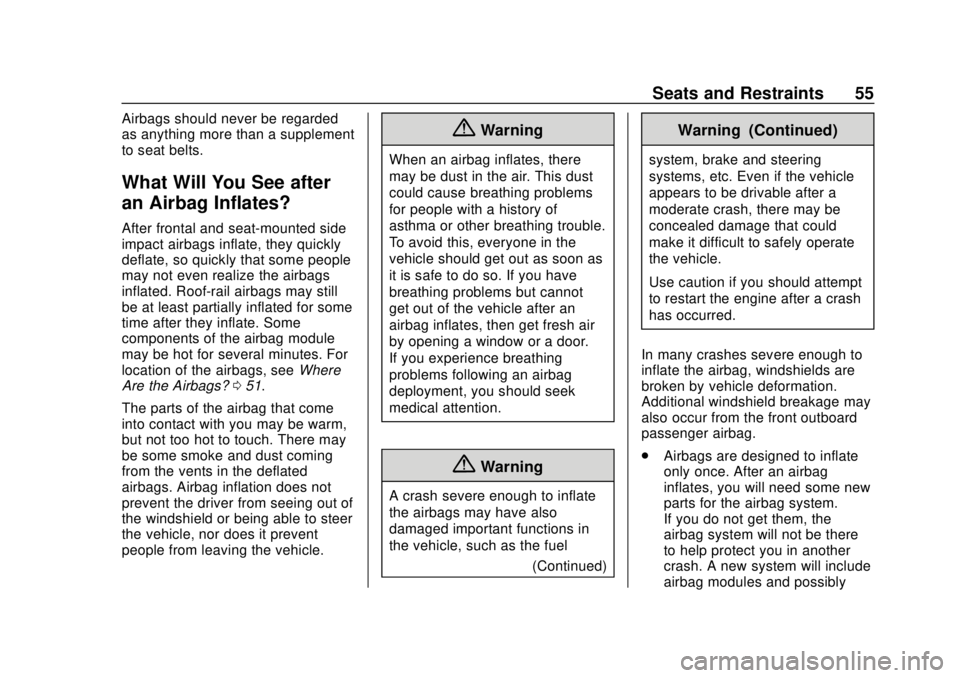
Chevrolet City Express Owner Manual (GMNA-Localizing-U.S./Canada-
11683523) - 2018 - CRC - 7/10/17
Seats and Restraints 55
Airbags should never be regarded
as anything more than a supplement
to seat belts.
What Will You See after
an Airbag Inflates?
After frontal and seat-mounted side
impact airbags inflate, they quickly
deflate, so quickly that some people
may not even realize the airbags
inflated. Roof-rail airbags may still
be at least partially inflated for some
time after they inflate. Some
components of the airbag module
may be hot for several minutes. For
location of the airbags, seeWhere
Are the Airbags? 051.
The parts of the airbag that come
into contact with you may be warm,
but not too hot to touch. There may
be some smoke and dust coming
from the vents in the deflated
airbags. Airbag inflation does not
prevent the driver from seeing out of
the windshield or being able to steer
the vehicle, nor does it prevent
people from leaving the vehicle.
{Warning
When an airbag inflates, there
may be dust in the air. This dust
could cause breathing problems
for people with a history of
asthma or other breathing trouble.
To avoid this, everyone in the
vehicle should get out as soon as
it is safe to do so. If you have
breathing problems but cannot
get out of the vehicle after an
airbag inflates, then get fresh air
by opening a window or a door.
If you experience breathing
problems following an airbag
deployment, you should seek
medical attention.
{Warning
A crash severe enough to inflate
the airbags may have also
damaged important functions in
the vehicle, such as the fuel (Continued)
Warning (Continued)
system, brake and steering
systems, etc. Even if the vehicle
appears to be drivable after a
moderate crash, there may be
concealed damage that could
make it difficult to safely operate
the vehicle.
Use caution if you should attempt
to restart the engine after a crash
has occurred.
In many crashes severe enough to
inflate the airbag, windshields are
broken by vehicle deformation.
Additional windshield breakage may
also occur from the front outboard
passenger airbag.
. Airbags are designed to inflate
only once. After an airbag
inflates, you will need some new
parts for the airbag system.
If you do not get them, the
airbag system will not be there
to help protect you in another
crash. A new system will include
airbag modules and possibly
Page 57 of 287
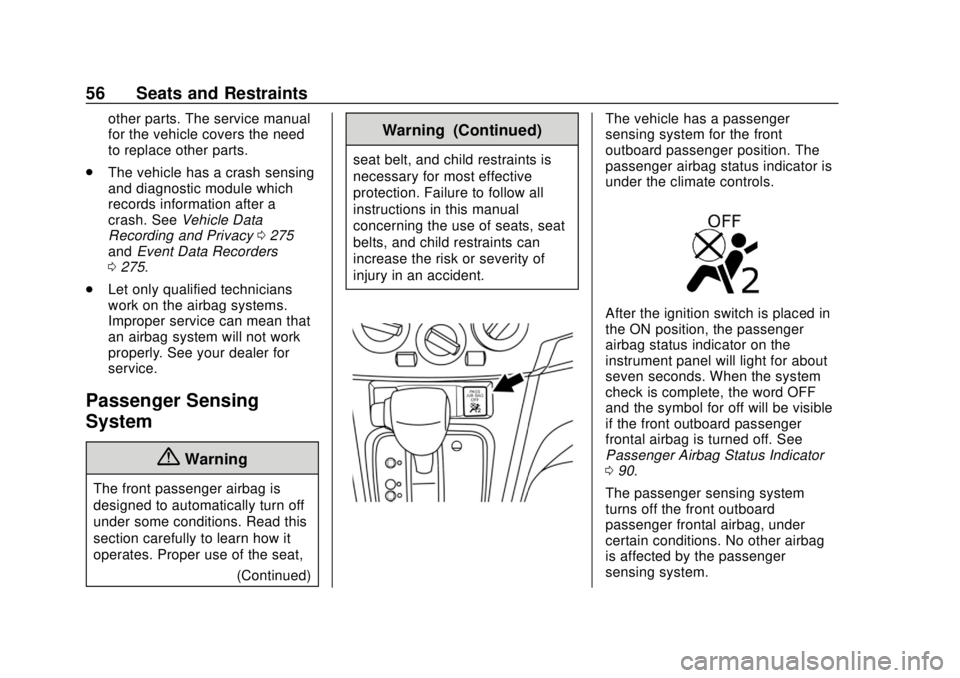
Chevrolet City Express Owner Manual (GMNA-Localizing-U.S./Canada-
11683523) - 2018 - CRC - 7/10/17
56 Seats and Restraints
other parts. The service manual
for the vehicle covers the need
to replace other parts.
. The vehicle has a crash sensing
and diagnostic module which
records information after a
crash. See Vehicle Data
Recording and Privacy 0275
and Event Data Recorders
0 275.
. Let only qualified technicians
work on the airbag systems.
Improper service can mean that
an airbag system will not work
properly. See your dealer for
service.
Passenger Sensing
System
{Warning
The front passenger airbag is
designed to automatically turn off
under some conditions. Read this
section carefully to learn how it
operates. Proper use of the seat,
(Continued)
Warning (Continued)
seat belt, and child restraints is
necessary for most effective
protection. Failure to follow all
instructions in this manual
concerning the use of seats, seat
belts, and child restraints can
increase the risk or severity of
injury in an accident.
The vehicle has a passenger
sensing system for the front
outboard passenger position. The
passenger airbag status indicator is
under the climate controls.
After the ignition switch is placed in
the ON position, the passenger
airbag status indicator on the
instrument panel will light for about
seven seconds. When the system
check is complete, the word OFF
and the symbol for off will be visible
if the front outboard passenger
frontal airbag is turned off. See
Passenger Airbag Status Indicator
090.
The passenger sensing system
turns off the front outboard
passenger frontal airbag, under
certain conditions. No other airbag
is affected by the passenger
sensing system.
Page 58 of 287
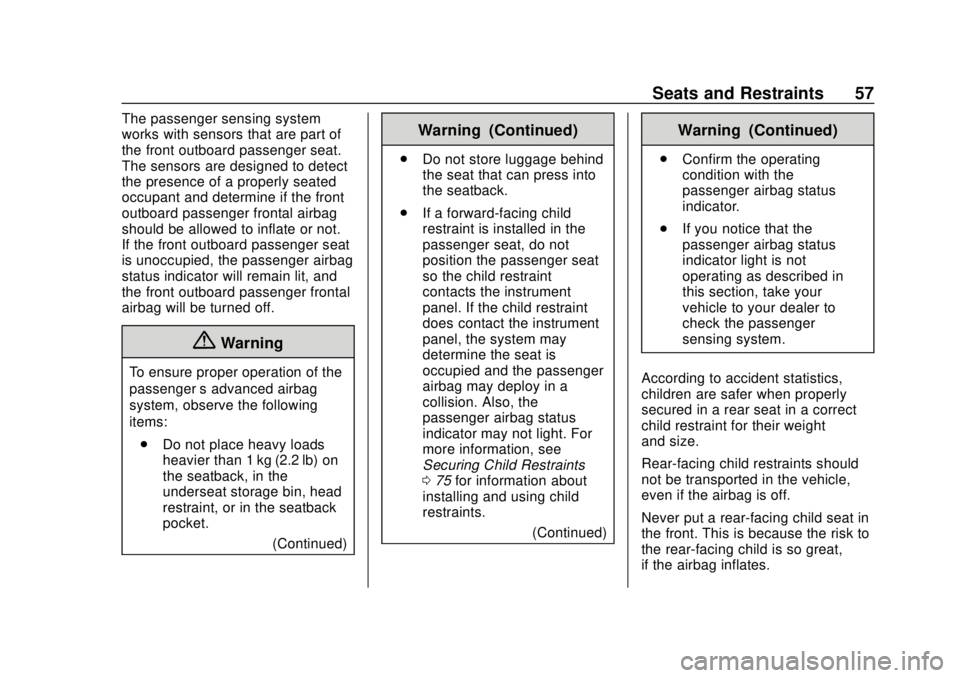
Chevrolet City Express Owner Manual (GMNA-Localizing-U.S./Canada-
11683523) - 2018 - CRC - 7/10/17
Seats and Restraints 57
The passenger sensing system
works with sensors that are part of
the front outboard passenger seat.
The sensors are designed to detect
the presence of a properly seated
occupant and determine if the front
outboard passenger frontal airbag
should be allowed to inflate or not.
If the front outboard passenger seat
is unoccupied, the passenger airbag
status indicator will remain lit, and
the front outboard passenger frontal
airbag will be turned off.
{Warning
To ensure proper operation of the
passenger’s advanced airbag
system, observe the following
items:
. Do not place heavy loads
heavier than 1 kg (2.2 lb) on
the seatback, in the
underseat storage bin, head
restraint, or in the seatback
pocket.
(Continued)
Warning (Continued)
.Do not store luggage behind
the seat that can press into
the seatback.
. If a forward-facing child
restraint is installed in the
passenger seat, do not
position the passenger seat
so the child restraint
contacts the instrument
panel. If the child restraint
does contact the instrument
panel, the system may
determine the seat is
occupied and the passenger
airbag may deploy in a
collision. Also, the
passenger airbag status
indicator may not light. For
more information, see
Securing Child Restraints
075 for information about
installing and using child
restraints.
(Continued)
Warning (Continued)
.Confirm the operating
condition with the
passenger airbag status
indicator.
. If you notice that the
passenger airbag status
indicator light is not
operating as described in
this section, take your
vehicle to your dealer to
check the passenger
sensing system.
According to accident statistics,
children are safer when properly
secured in a rear seat in a correct
child restraint for their weight
and size.
Rear-facing child restraints should
not be transported in the vehicle,
even if the airbag is off.
Never put a rear-facing child seat in
the front. This is because the risk to
the rear-facing child is so great,
if the airbag inflates.
Page 59 of 287
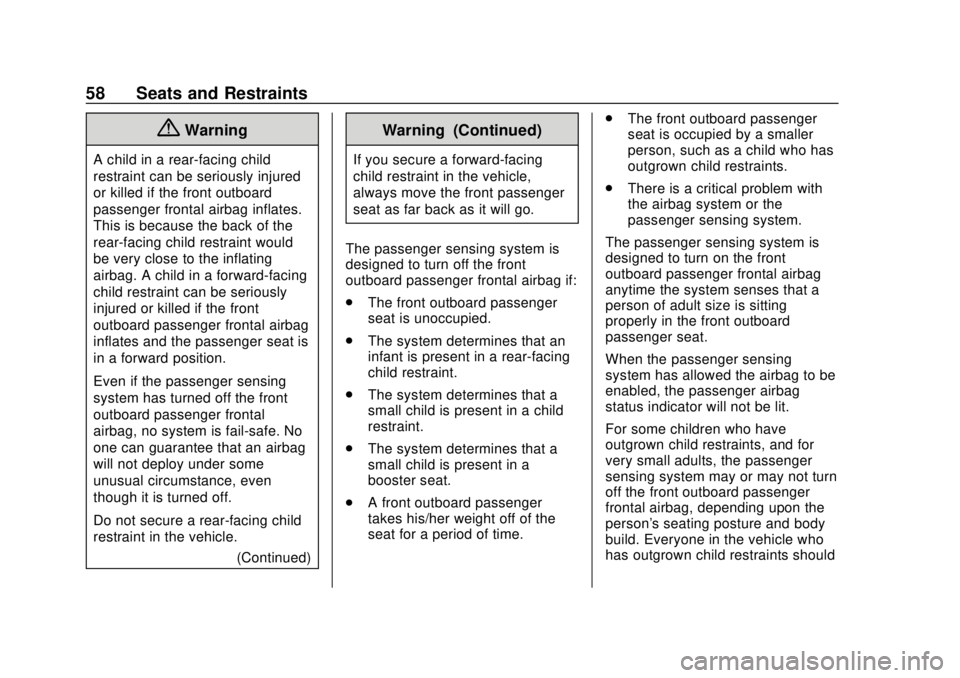
Chevrolet City Express Owner Manual (GMNA-Localizing-U.S./Canada-
11683523) - 2018 - CRC - 7/10/17
58 Seats and Restraints
{Warning
A child in a rear-facing child
restraint can be seriously injured
or killed if the front outboard
passenger frontal airbag inflates.
This is because the back of the
rear-facing child restraint would
be very close to the inflating
airbag. A child in a forward-facing
child restraint can be seriously
injured or killed if the front
outboard passenger frontal airbag
inflates and the passenger seat is
in a forward position.
Even if the passenger sensing
system has turned off the front
outboard passenger frontal
airbag, no system is fail-safe. No
one can guarantee that an airbag
will not deploy under some
unusual circumstance, even
though it is turned off.
Do not secure a rear-facing child
restraint in the vehicle.(Continued)
Warning (Continued)
If you secure a forward-facing
child restraint in the vehicle,
always move the front passenger
seat as far back as it will go.
The passenger sensing system is
designed to turn off the front
outboard passenger frontal airbag if:
. The front outboard passenger
seat is unoccupied.
. The system determines that an
infant is present in a rear-facing
child restraint.
. The system determines that a
small child is present in a child
restraint.
. The system determines that a
small child is present in a
booster seat.
. A front outboard passenger
takes his/her weight off of the
seat for a period of time. .
The front outboard passenger
seat is occupied by a smaller
person, such as a child who has
outgrown child restraints.
. There is a critical problem with
the airbag system or the
passenger sensing system.
The passenger sensing system is
designed to turn on the front
outboard passenger frontal airbag
anytime the system senses that a
person of adult size is sitting
properly in the front outboard
passenger seat.
When the passenger sensing
system has allowed the airbag to be
enabled, the passenger airbag
status indicator will not be lit.
For some children who have
outgrown child restraints, and for
very small adults, the passenger
sensing system may or may not turn
off the front outboard passenger
frontal airbag, depending upon the
person's seating posture and body
build. Everyone in the vehicle who
has outgrown child restraints should
Page 60 of 287
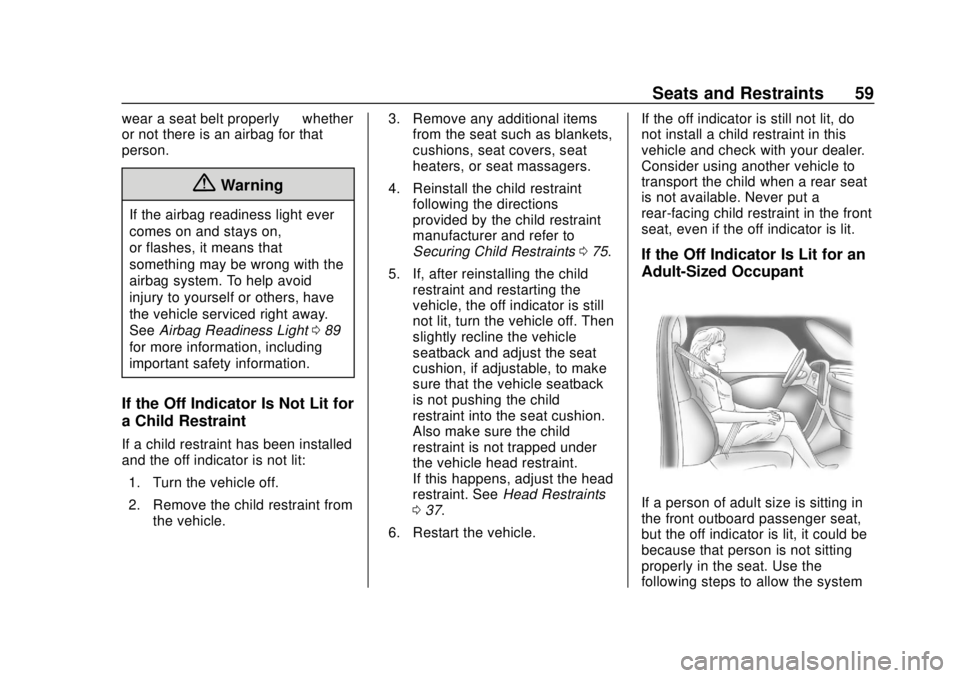
Chevrolet City Express Owner Manual (GMNA-Localizing-U.S./Canada-
11683523) - 2018 - CRC - 7/10/17
Seats and Restraints 59
wear a seat belt properly—whether
or not there is an airbag for that
person.
{Warning
If the airbag readiness light ever
comes on and stays on,
or flashes, it means that
something may be wrong with the
airbag system. To help avoid
injury to yourself or others, have
the vehicle serviced right away.
See Airbag Readiness Light 089
for more information, including
important safety information.
If the Off Indicator Is Not Lit for
a Child Restraint
If a child restraint has been installed
and the off indicator is not lit:
1. Turn the vehicle off.
2. Remove the child restraint from the vehicle. 3. Remove any additional items
from the seat such as blankets,
cushions, seat covers, seat
heaters, or seat massagers.
4. Reinstall the child restraint following the directions
provided by the child restraint
manufacturer and refer to
Securing Child Restraints 075.
5. If, after reinstalling the child restraint and restarting the
vehicle, the off indicator is still
not lit, turn the vehicle off. Then
slightly recline the vehicle
seatback and adjust the seat
cushion, if adjustable, to make
sure that the vehicle seatback
is not pushing the child
restraint into the seat cushion.
Also make sure the child
restraint is not trapped under
the vehicle head restraint.
If this happens, adjust the head
restraint. See Head Restraints
0 37.
6. Restart the vehicle. If the off indicator is still not lit, do
not install a child restraint in this
vehicle and check with your dealer.
Consider using another vehicle to
transport the child when a rear seat
is not available. Never put a
rear-facing child restraint in the front
seat, even if the off indicator is lit.
If the Off Indicator Is Lit for an
Adult-Sized Occupant
If a person of adult size is sitting in
the front outboard passenger seat,
but the off indicator is lit, it could be
because that person is not sitting
properly in the seat. Use the
following steps to allow the system